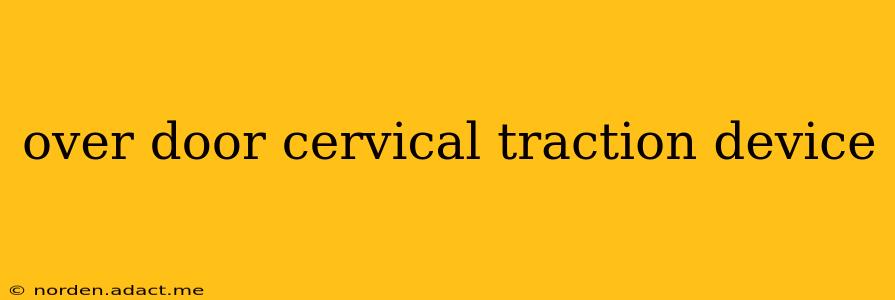Cervical traction, a therapy that gently stretches the neck to relieve pressure on the spine, is a popular method for managing neck pain. Over-the-door cervical traction devices offer a convenient and affordable way to access this therapy from the comfort of your home. But with so many options available, understanding how they work, their benefits, and potential drawbacks is crucial before making a purchase. This comprehensive guide will explore everything you need to know about over-the-door cervical traction devices.
What is a Cervical Traction Device?
A cervical traction device is a tool used to gently stretch the neck and alleviate pressure on the cervical spine (the neck region of the spine). This stretching can help to:
- Reduce pain: By creating space between the vertebrae, traction can lessen pressure on nerves and reduce pain.
- Improve range of motion: Gentle stretching can improve neck flexibility and reduce stiffness.
- Increase blood flow: Traction can enhance blood circulation to the neck and surrounding muscles, promoting healing.
Over-the-door devices are particularly convenient as they utilize a doorframe for support, eliminating the need for bulky equipment or professional assistance. They typically consist of a head harness, straps, and a mechanism for adjusting the traction force.
How Does an Over-the-Door Cervical Traction Device Work?
These devices work by using the doorframe as an anchor point. You place the harness around your head and adjust the straps to create a gentle, controlled pull on your neck. The weight of your body, or a counterweight system in some models, provides the traction force. The amount of traction can usually be adjusted to suit your comfort level and needs.
What are the Benefits of Using an Over-the-Door Cervical Traction Device?
- Convenience: The primary advantage is convenience. You can perform traction at home at your own pace.
- Cost-effectiveness: These devices are generally less expensive than other traction methods, such as those performed by physical therapists.
- Self-treatment: You can control the intensity and duration of the traction, making it a personalized treatment option.
- Improved comfort: Many users report experiencing significant pain relief and improved neck mobility.
What are the Potential Drawbacks of Using an Over-the-Door Cervical Traction Device?
- Incorrect use: Incorrect usage can lead to injury or worsen existing conditions. Always follow the manufacturer's instructions carefully.
- Not suitable for all: Individuals with certain medical conditions, such as osteoporosis, recent neck injuries, or certain types of arthritis, should consult their doctor before using a traction device.
- Limited traction force: Over-the-door devices generally offer lower traction force compared to professional-grade equipment.
- Potential discomfort: Some individuals may find the harness uncomfortable, especially during initial use.
Who Should Use an Over-the-Door Cervical Traction Device?
An over-the-door cervical traction device may be beneficial for individuals experiencing:
- Muscle strain: Gentle traction can help relax strained neck muscles.
- Spinal stenosis: While not a cure, traction can provide temporary relief from nerve compression.
- Headaches (cervicogenic): Headaches originating from the neck can sometimes be alleviated with traction.
Who Should NOT Use an Over-the-Door Cervical Traction Device?
Individuals with the following conditions should avoid using an over-the-door cervical traction device without consulting their doctor:
- Recent neck injury: Traction could worsen a recent injury.
- Osteoporosis: Increased risk of vertebral fracture.
- Unstable neck: Pre-existing instability could be aggravated.
- Rheumatoid arthritis: Inflammation could be worsened.
- Spinal tumors or infections: Traction could be harmful.
- Pregnancy: Consult your doctor before use.
How to Use an Over-the-Door Cervical Traction Device Safely
- Follow instructions: Always read and follow the manufacturer's instructions carefully.
- Start slowly: Begin with short sessions and gradually increase the duration and traction force.
- Listen to your body: Stop if you experience any pain or discomfort.
- Maintain proper posture: Maintain good posture throughout the session.
- Consult a healthcare professional: If you have any concerns, consult your doctor or physical therapist.
What is the difference between over-the-door cervical traction and other types?
Other types of cervical traction include those performed by a physical therapist using specialized equipment, inversion tables, and handheld devices. Over-the-door versions are significantly more affordable and convenient for home use, but they generally offer less control and lower traction force than professional methods.
Are there any risks associated with using an over-the-door cervical traction device?
Yes, there are potential risks. Improper use can lead to injury or aggravate existing conditions. It's crucial to follow instructions, start slowly, and listen to your body. Consult a healthcare professional if you have any concerns or pre-existing conditions.
This guide provides general information and should not be considered medical advice. Always consult a healthcare professional before starting any new treatment, including cervical traction. Choosing the right over-the-door cervical traction device and using it correctly can offer a path toward effective neck pain management from the comfort of your own home. Remember, safety and proper usage are paramount.
